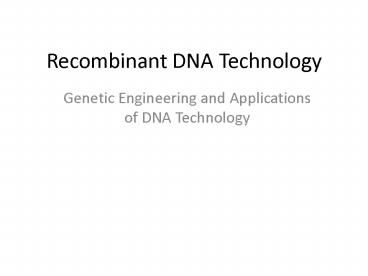Recombinant DNA Technology - PowerPoint PPT Presentation
1 / 16
Title:
Recombinant DNA Technology
Description:
The host cell will make copies of the recombinant DNA each time it divides. Cloning of Animals. The most famous cloned animal is Dolly. She was a sheep cloned in 1997 ... – PowerPoint PPT presentation
Number of Views:167
Avg rating:3.0/5.0
Title: Recombinant DNA Technology
1
Recombinant DNA Technology
- Genetic Engineering and Applications of DNA
Technology
2
Genetic Engineering
- Genetic engineering is when DNA is cut or cleaved
from one organism into small fragments and then
inserted into a host organism of the same or a
different species - Recombinant DNA is made by connecting or
recombining fragments of DNA from different
sources
3
Transgenic Organisms
- Recombinant DNA can be inserted into a host
organisms chromosomes and the organism will use
the foreign DNA as if it were its own - When an organism contains foreign DNA it is
called a transgenic organism - There are three steps to the process
- 1. the foreign DNA fragment is isolated
- the DNA fragment is attached to a carrier
- 3. the DNA is transferred into the host organism
4
Restriction Enzymes Cleave DNA
- To isolate the DNA fragment it must be cut from
the chromosomes - Restriction enzymes are bacterial proteins that
have the ability to cut both strands of the DNA
molecule at a specific nucleotide sequence - There are hundreds of restriction enzymes
5
Vectors Transfer DNA
- Fragments of DNA can not just be put into another
organism - A vector is the means by which DNA from another
species can be carried into the host cell - Vectors can be biological or mechanical
6
Vectors
- Biological vectors include viruses and plasmids
- A plasmid is a small ring of DNA found in a
bacterial cell - Two examples of mechanical vectors are a
micropipette that is inserted into a cell and a
microscopic metal bullet coated with DNA that is
show into the cell with a gene gun
7
Gene Cloning
- After the foreign DNA has been inserted into a
plasmid the recombined DNA is transferred to a
bacterial cell - The plasmid can make copies of itself and can
make up to 500 copies per bacterial cell - An advantage of using bacterial cells is that
they reproduce quickly
8
Gene Cloning
- Clones are genetically identical copies
- Each identical recombinant DNA molecule is called
a gene clone - Plasmids can also be used to deliver the genes to
animal or plant cells, when then use the
recombinant DNA - The host cell will make copies of the recombinant
DNA each time it divides
9
Cloning of Animals
- The most famous cloned animal is Dolly
- She was a sheep cloned in 1997
- Other mammals such as mice, cattle, goats and
pigs have been cloned - This could help ranchers clone productive,
healthy animals
10
Polymerase Chain Reaction
- One way to make copies of DNA outside of an
organism is polymerase chain reaction - This involves heating the DNA until the DNA
strands separate from each other - The machine can then make copies
- The PCR can make over 1 million copies in a day
11
Sequencing DNA
- Genetic engineering can also let scientists
determine the correct order of DNA sequences so a
mutation can be identified - Millions of copies of the DNA is made using PCR
- The strands are separated from one another
- The single-stranded fragments are put into four
different test tubes - One for each base (A, C, T, G)
12
Sequencing DNA
- One nucleotide in each tube is tagged with a
different fluorescent color - The reactions produce complementary strands of
different lengths - These strands are separated by gel
electrophoresis which produces a pattern - The short strands travel the farthest while the
long strands travel the shortest distance
13
Applications of DNA Technology
- Industry
- Species of bacteria have been engineered to
produce chemical compounds used by humans - Scientists have modified E.coli to produce the
indigo dye in denim blue jeans - Bacteria is also used in the production of
cheese, laundry detergent, pulp and paper
products and sewage treatment
14
Recombinant DNA in medicine
- Pharmaceutical companies are using recombinant
DNA to treat human diseases - Recombinant bacteria is used for the production
of the human growth hormone to treat pituitary
dwarfism - Also used to produce insulin
- Human antibodies, hormones, vaccines, enzymes and
other compounds needed to treat and detect
disease are being used
15
Transgenic Animals
- Scientists can study disease by using transgenic
animals - Mice are often used
- Mice and human chromosomes are similar
- The roundworm and fruit fly (Drosophilia
melangaster) are also used
16
Recombinant DNA in agriculture
- Crops have been produced that taste better, stay
fresh longer, and are disease resistant - Products such as corn, broccoli, cotton and
potatoes have been developed to be resistant to
certain insects - There is also research to put more vitamins in
crops to be used in developing countries































